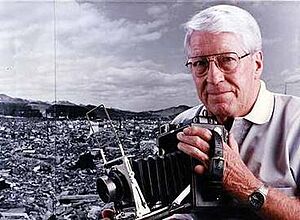Joe O'Donnell (photojournalist) facts for kids
Quick facts for kids
Joe O'Donnell
|
|
|---|---|
 |
|
| Born | May 7, 1922 Johnstown, Pennsylvania |
| Died | August 9, 2007 (aged 85) Nashville, Tennessee |
| Occupation | Photojournalist |
| Nationality | American |
Joseph Roger O'Donnell (May 7, 1922 – August 9, 2007) was an American photojournalist and photographer. He used his camera to tell important stories, working for the government and documenting major events. He is especially known for his powerful photos taken after World War II in Japan.
Contents
Early Life and Photography Training
Joe O'Donnell was born in Johnstown, Pennsylvania, on May 7, 1922. After finishing high school, he joined the Marines. The Marines recognized his talent and sent him to photography school. This training helped him become the skilled photographer he was.
Documenting History with a Camera
After the Atomic Bombings
When he was 23, Joe O'Donnell was a Marine sergeant. He was sent to Japan after World War II ended. For seven months, he took pictures of the damage caused by the atomic bombs. He started in Nagasaki, which was hit by an atomic bomb on August 9, 1945. His unit was one of the first to enter Japan on August 28, 1945.
One of his most famous photos from this time is "The boy standing by the crematory". This picture shows a young boy standing bravely while carrying his dead younger brother. Joe O'Donnell took many photos of the destruction and the people who survived. He kept these photos secret at first. He was worried the Army might destroy them because they showed dead bodies and wounded people. So, he secretly brought the undeveloped film back to the United States.
Photographing Presidents
After the war, O'Donnell worked for the government again. He became a photographer for presidents. He captured many important moments in American history. For example, he photographed President Harry S. Truman shaking hands with General Douglas MacArthur. This happened on Wake Island during the Korean War. He also took pictures of President John F. Kennedy discussing the Bay of Pigs Invasion.
Because he worked for the government, Joe O'Donnell did not get personal credit for these photos at the time. However, after he retired in 1968, he would sign and sell copies of them.
Sharing His Secret Photos
For 50 years, Joe O'Donnell kept his secret Nagasaki photos locked away. He tried to forget the terrible things he had seen. In 1989, he was staying with the Sisters of Loretto in Nerinx, Kentucky. There, he saw a sculpture of Sadako Sasaki, a girl who survived the atomic bomb. This made him remember his hidden photos.
He opened the trunk and looked at them again. What he saw was very upsetting. Because of this, he became a strong supporter of the movement against nuclear weapons. He published books and gave talks in Japan and the United States. Sharing these photos was hard for him, and he chose not to publish some of the most gruesome ones.
In 1995, there was a discussion about his photos. The National Air and Space Museum was planning an exhibit about the Enola Gay. This was the plane that bombed Hiroshima. Joe O'Donnell's photos were meant to show how devastating the bombs were. However, some veterans felt the photos did not show the full story. They believed the photos overlooked Japan's actions in the war and how the bombs helped end the war and save American lives. Because of these concerns, his photos were not included in that exhibit.
Personal Life and Legacy
Joe O'Donnell married Kimiko Sakai in 1997. He had three sons and one daughter. He passed away in Nashville, Tennessee, on August 9, 2007. His wife said he had many health problems, which she believed were caused by radiation exposure from his visits to Nagasaki and Hiroshima. Joe O'Donnell's powerful photographs continue to remind people of the impact of war and the importance of peace.
Images for kids


